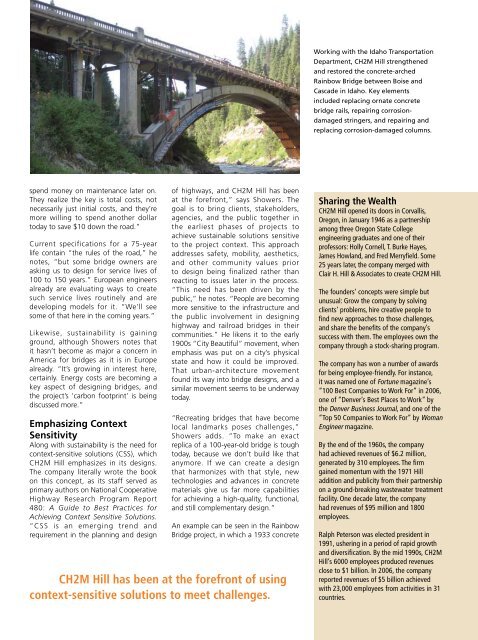ASPIRE Spring 08 - Aspire - The Concrete Bridge Magazine
ASPIRE Spring 08 - Aspire - The Concrete Bridge Magazine
ASPIRE Spring 08 - Aspire - The Concrete Bridge Magazine
Create successful ePaper yourself
Turn your PDF publications into a flip-book with our unique Google optimized e-Paper software.
Working with the Idaho TransportationDepartment, CH2M Hill strengthenedand restored the concrete-archedRainbow <strong>Bridge</strong> between Boise andCascade in Idaho. Key elementsincluded replacing ornate concretebridge rails, repairing corrosiondamagedstringers, and repairing andreplacing corrosion-damaged columns.spend money on maintenance later on.<strong>The</strong>y realize the key is total costs, notnecessarily just initial costs, and they’remore willing to spend another dollartoday to save $10 down the road.”Current specifications for a 75-yearlife contain “the rules of the road,” henotes, “but some bridge owners areasking us to design for service lives of100 to 150 years.” European engineersalready are evaluating ways to createsuch service lives routinely and aredeveloping models for it. “We’ll seesome of that here in the coming years.”Likewise, sustainability is gainingground, although Showers notes thatit hasn’t become as major a concern inAmerica for bridges as it is in Europealready. “It’s growing in interest here,certainly. Energy costs are becoming akey aspect of designing bridges, andthe project’s ‘carbon footprint’ is beingdiscussed more.”Emphasizing ContextSensitivityAlong with sustainability is the need forcontext-sensitive solutions (CSS), whichCH2M Hill emphasizes in its designs.<strong>The</strong> company literally wrote the bookon this concept, as its staff served asprimary authors on National CooperativeHighway Research Program Report480: A Guide to Best Practices forAchieving Context Sensitive Solutions.“CSS is an emerging trend andrequirement in the planning and designof highways, and CH2M Hill has beenat the forefront,” says Showers. <strong>The</strong>goal is to bring clients, stakeholders,agencies, and the public together inthe earliest phases of projects toachieve sustainable solutions sensitiveto the project context. This approachaddresses safety, mobility, aesthetics,and other community values priorto design being finalized rather thanreacting to issues later in the process.“This need has been driven by thepublic,” he notes. “People are becomingmore sensitive to the infrastructure andthe public involvement in designinghighway and railroad bridges in theircommunities.” He likens it to the early1900s “City Beautiful” movement, whenemphasis was put on a city’s physicalstate and how it could be improved.That urban-architecture movementfound its way into bridge designs, and asimilar movement seems to be underwaytoday.“Recreating bridges that have becomelocal landmarks poses challenges,”Showers adds. “To make an exactreplica of a 100-year-old bridge is toughtoday, because we don’t build like thatanymore. If we can create a designthat harmonizes with that style, newtechnologies and advances in concretematerials give us far more capabilitiesfor achieving a high-quality, functional,and still complementary design.”An example can be seen in the Rainbow<strong>Bridge</strong> project, in which a 1933 concreteCH2M Hill has been at the forefront of usingcontext-sensitive solutions to meet challenges.Sharing the WealthCH2M Hill opened its doors in Corvallis,Oregon, in January 1946 as a partnershipamong three Oregon State Collegeengineering graduates and one of theirprofessors: Holly Cornell, T. Burke Hayes,James Howland, and Fred Merryfield. Some25 years later, the company merged withClair H. Hill & Associates to create CH2M Hill.<strong>The</strong> founders’ concepts were simple butunusual: Grow the company by solvingclients’ problems, hire creative people tofind new approaches to those challenges,and share the benefits of the company’ssuccess with them. <strong>The</strong> employees own thecompany through a stock-sharing program.<strong>The</strong> company has won a number of awardsfor being employee-friendly. For instance,it was named one of Fortune magazine’s“100 Best Companies to Work For” in 2006,one of “Denver’s Best Places to Work” bythe Denver Business Journal, and one of the“Top 50 Companies to Work For” by WomanEngineer magazine.By the end of the 1960s, the companyhad achieved revenues of $6.2 million,generated by 310 employees. <strong>The</strong> firmgained momentum with the 1971 Hilladdition and publicity from their partnershipon a ground-breaking wastewater treatmentfacility. One decade later, the companyhad revenues of $95 million and 1800employees.Ralph Peterson was elected president in1991, ushering in a period of rapid growthand diversification. By the mid 1990s, CH2MHill’s 6000 employees produced revenuesclose to $1 billion. In 2006, the companyreported revenues of $5 billion achievedwith 23,000 employees from activities in 31countries.
















